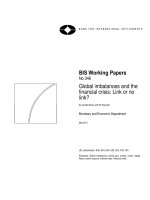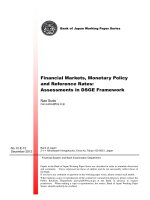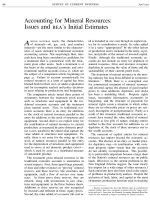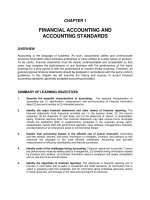Critical Financial Accounting Problems Issues and Solutions_4 docx
Bạn đang xem bản rút gọn của tài liệu. Xem và tải ngay bản đầy đủ của tài liệu tại đây (144.92 KB, 20 trang )
46 Critical Financial Accounting Problems
date. The accounting treatment at the date of declaration consists of deb-
iting retained earnings or scrip dividends declared and crediting notes
payable to stockholders or scrip dividend payable. At the date of distri-
bution, the firm debits the note payable or scrip payable, and the related
interest expense and credit cash. For example, let’s assume that the Ban-
nos Company declared, on June 17, 1996, a scrip dividend in the form
of a three-month promissory note amount to $1 a share on 3,000,000
shares outstanding. The interest rate on the notes is 10% per year. The
following entries are required:
1. At the date of declaration, June 17, 1996
Retained Earnings (Scrip
Dividends Declared) 3,000,000
Notes Payable to
Stockholders (Scrip
Dividends Payable) 3,000,000
($1 ϫ 3,000,000)
2. At the date of payment, September 17, 1996
Note Payable to Stockholders 3,000,000
Interest Expense 75,000
($3,000,000 ϫ .10 ϫ 3/12)
Cash 3,075,000
Liquidating Dividends
Dividends paid based on other than retained earnings are called liq-
uidating dividends, as a return of contributed capital rather than a dis-
tribution of retained earnings. They are treated as a reduction of
contributed capital, either additional paid-in-capital or a special contra-
contributed capital account, designated as Contributed Capital Distrib-
uted as a Liquidating Dividend.
For example, let’s assume that the Weigandt Company issued dividend
to its common stockholders of $2,500,000 of which $1,000,000 is con-
sidered income and the rest a return of contributed capital. The following
entries are required:
A. At the date of declaration
Retained Earnings 1,000,000
Additional Paid-in-Capital 1,500,000
Contributed Capital and Retained Earnings 47
Dividends Payable 2,500,000
B. At the date of payment
Dividends Payable 2,500,000
Cash 2,500,000
Stock Dividends
A firm with adequate retained earnings but insufficient liquidity may
elect to issue stock dividends by a pro rate distribution of additional
shares of the firm’s own stock to its stockholders. The transaction is
made by a capitalization of retained earnings resulting in a reduction of
retained earnings and an increase in some contributed capital accounts.
No corporate assets are distributed; the value of the total stockholders’
equity remains unchanged as well as each stockholder’s percentage own-
ership in the firm. Accounting for stock dividends differs depending on
the size of the issue:
A. For small stock dividend, that is less than 20–25% of the common shares
outstanding at the time of the dividend declaration, fair market value is used
to capitalize retained earnings and an increase in capital stock and additional
paid-in-capital.
B. For large stock dividend, that is more than 20–25% of the common shares
outstanding at the time of the dividend declaration, par value is issued to
capitalize retained earnings resulting in a reduction of retained earnings and
an increase in capital stock.
To illustrate the accounting for small stock dividend, let’s assume a
corporation that has the following stockholders’ equity prior to the is-
suance of a small stock dividend:
Common Stock, $20 par (30,000
shares issued
and outstanding) $600,000
Additional Paid-in-Capital 300,000
Retained Earnings 600,000
Total Stockholders’ Equity $1,500,000
Let’s also assume that the firm issued a 20% stock dividend on a date
where the stock was selling at $25 per share. The fair value of the 6,000
shares is $150,000. The following entries are required:
48 Critical Financial Accounting Problems
A. At the date of declaration
Retained Earnings 150,000
Common Stock Dividend
Distributable 120,000
Additional Paid-in-Capital
from Stock Dividend 30,000
B. At the date of issuance
Common Stock Dividend
Distribution 120,000
Common Stock, $20 par 120,000
Following the issuance the stockholders’ equity is as follows:
Common Stock, $20 par $720,000
(36,000 shares issued and
outstanding)
Additional Paid-in-Capital 330,000
Retained Earnings 450,000
Total Stockholders’ Equity $1,500,000
Let’s now assume that the firm issued instead a 50% stock dividend.
The following entries are required at the time of declaration.
Retained Earnings (50% ϫ
30,000 share ϫ $20) 300,000
Common Stock Dividend
Distributable 300,000
At the time of distribution the following entry is required:
Common Stock Dividend
Distributable 300,000
Common Stock, $20 par 300,000
Following the issuance the stockholders’ equity is as follows:
Common Stock, $20 par
(45,000) $900,000
Additional Paid-in-Capital 300,000
Retained Earnings 300,000
Total Stockholders’ Equity 1,500,000
Contributed Capital and Retained Earnings 49
Note that the large stock dividend is treated as a stock split, that is, a
split-up effected in the form of a dividend. In fact, for a stock split no
entry is required except a memorandum to notice the increase in the
number of shares and the decrease in the par value. For example, a 2-
for-1 split of $6,000 shares at $10 par value results in a common stock
of $16,000 shares at $5 par value.
APPROPRIATIONS OF RETAINED EARNINGS
To issue that the retained earnings may be used for more than the
declaration and the payment of dividends, firms may appropriate (re-
strict) retained earnings, ‘‘provided that it is shown within the stock-
holders’ equity section of the balance sheet and is clearly identified as
an appropriation of retained earnings.’’
2
The appropriation may be mo-
tivated by (a) legal restriction, (b) contractual restrictions, (c) existence
of possible or expected loss, and (d) protection of working capital po-
sition.
3
Note, however, that FASB Statement No. 5 clearly states that
‘‘Costs or losses shall not be charged to an appropriation of retained
earnings, and no part of the appropriation shall be transferred to in-
come.’’
4
To illustrate the formal entries associated with appropriation of re-
tained earnings, let’s assume that the XYZ Company is required by a
debt covenant that an appropriation for sinking fund or appropriation for
bond indebtedness is to be created by transfer from retained earnings of
$500,000 a year for the 10-year life of the bonds. Therefore the entry
for each year is:
Retained Earnings 500,000
Retained Earnings
Appropriated for Sinking
Fund 500,000
At the end of 10 years and assuming the bonds are retired, the following
entry is required:
Retained Earnings Appropriated
for Sinking Fund 500,000
Retained Earnings 500,000
50 Critical Financial Accounting Problems
NOTES
1. Loren A. Nikolai and John D. Bazley, Intermediate Accounting, 6th ed.
(Cincinnati, Ohio: South-Western Publishing Co., 1994), p. 852.
2. ‘‘Accounting for Contingencies,’’ FASB Statement of Financial Account-
ing Standards No. 5 (Stamford, Conn.: FASB, 1975), par. 15.
3. Donald E. Kieso and Jerry J. Weygandt, Intermediate Accounting, 4th ed.
(New York: John Wiley & Sons, 1995), p. 786.
4. ‘‘Accounting for Contingencies,’’ par. 15.
3
Investments
INTRODUCTION
Firms buy bonds and stocks to generate investment revenues and divi-
dend revenues as well as for speculative reasons. The different objectives
for these investments dictate different accounting treatments to insure a
fair reporting. Accordingly, this chapter examines the conventional ac-
counting treatments for investments in both debt securities and equity
securities.
TYPES OF INVESTMENTS IN DEBT SECURITIES
Investments in debt securities and investments in equity securities that
have readily determinable fair values are the subject of FASB Statement
No. 115. Three types of securities are presented:
1. Debt Securities Held to Maturity: The firm has the positive interest and ability
to hold those securities to maturity.
2. Trading Securities: They are acquired and held for the sole purpose of gen-
erating short-term income through sale.
3. Securities Available-for-Sale: They are securities that are not classified as
either debt securities held to maturity or trading securities.
At the time of acquisition each of these types of securities is accounted
for at cost with the income statement including dividend revenue, interest
52 Critical Financial Accounting Problems
revenue and realized holdings gains and losses. The subsequent valuation
in the balance sheet and the recognition of unrealized holdings gains and
losses differ, however, as follows:
1. Debt securities held to maturity, valued at their amortized cost, that is, the
acquisition cost after amortization of any premium or discount each period
as interest revenue is recognized. Therefore, no unrealized holdings gains or
losses are recognized.
2. Trading securities are valued at their fair value on the balance sheet date
which leads to the recognition of unrealized holdings gains and losses in the
income statement.
3. Securities available for sale are valued at fair value on the balance sheet date
which leads to the recognition of unrealized holdings gains and losses as a
separate component of stockholders’ equity until realized.
ACCOUNTING FOR INVESTMENTS IN DEBT
SECURITIES
Investments in Debt Securities Held to Maturity
As stated earlier, investments in debt securities held to maturity are
valued at cost at the time of acquisition, then subsequently at amortized
cost. Any premium or discount is amortized over the remaining life of
the bonds, thereby allocating the proper amount of revenue to each pe-
riod. Let’s illustrate both the situations of premium and discount.
Situation 1: Case of a Premium
Let’s assume that the Jackson Company purchased, on January 1, 1996,
investments in bonds to be held to maturity with a face value of $200,000
of five-year bonds paying semi-annual interest with a stated rate of
12% and an effective interest rate of 10% for $215,443.42. On January
1, 1996, the Jackson Company makes the following entry:
Investments in Debt Securities
Held to Maturity $215,443.42
Cash 215,443.42
Exhibit 3.1 shows the schedule for computing interest revenue and
premium amortization using the effective interest method. On June 30,
1996, the first interest receipt is recorded as follows:
Investments 53
Exhibit 3.1
Jackson Company: Schedule of Bond Premium Amortization, Effective
Interest Method, Semi-Annual Interest Payments, 12% Bond Sold to
Yield 10%
(a) $200,000 (face value) ϫ 0.12 (stated rate) ϫ
1
⁄
2
year
(b) Previous book value ϫ 0.10 (effective rate) ϫ
1
⁄
2
year
(c) (a) Ϫ (b)
(d) Previous book value Ϫ (c)
Cash $12,000
Investments in Debt
Securities Held to Maturity 1,227.83
Interest Revenue 10,710.77
Situation 2: Case of a Discount
Let’s assume that the Jackson Company purchased, on January 1, 1996,
$200,000 of five-year bonds paying semi-annual interest rate with a
54 Critical Financial Accounting Problems
Exhibit 3.2
Jackson Company: Schedule of Bond Discount Amortization, Effective
Interest Method, Semi-Annual Interest Payments, 12% Bonds Sold to
Yield 14%
(a) $200,000 (face value) ϫ 0.12 (stated rate) ϫ
1
⁄
2
year
(b) Previous book value ϫ 0.14 (effective rate) ϫ
1
⁄
2
year
(c) (b)Ϫ (a)
(d) Previous book value ϩ (c)
stated rate of 12% and an effective rate of 14% for $185,952.78. On
January 1, 1996, the Jackson Company makes the following entry:
Investments in Debt Securities
Held to Maturity 185,952.78
Cash 185,952.78
Exhibit 3.2 illustrates the schedule for computing the interest revenue
and the discount amortization. On June 30, 1996, the first interest receipt
is recorded as follows:
Investments 55
Cash 12,000
Investments in Debt Securities
Held to Maturity 1,016.69
Interest Revenue 13,016.69
Let’s assume that on November 1, 2000, the Jackson Company sells
the investment at 99
3
⁄
4
plus interest. The discount amortization from
July 1, 2000 until November 1, 2000 is $1,246.09 (1,869.14 ϫ 4/6). This
amortization is recognized on November 1, 2000 as follows:
Investments in Debt Securities
Held to Maturity 1,246.09
Interest Revenue 1,264.09
Therefore the gain or loss on the rate is computed as follows:
A. Book Value of the Bonds on November 1, 2000
1. Amortized Cost, July 1, 2000 ϭ $198,130.68
2. Plus: Discount Amortization up
until November 1, 2000 ϭ 1,246.09
3. Book Value 199,376.77
B. Selling Price of Bonds 199,500.00
C. Gain on Sale of Bonds ($199,500 Ϫ
$199,376.77) 123.23
Therefore, the following entry to record the sale is made on November
1, 2000.
Cash 207,500
Interest Revenue ($12,000
ϫ 4/6) 8,000.00
Investments in Debt
Securities Held to Maturity 199,376.77
Gain in Sale of Securities 123.23
Investments in Available-for-Sale Securities
As stated earlier, investments in available-for-sale securities are re-
corded at cost at acquisition, then are reported at fair value in balance
sheet date, with the unrealized gains and losses accounted for as a sep-
56 Critical Financial Accounting Problems
arate contra-account to stockholders’ equity until realized. To illustrate,
let’s assume that the Dodd Company purchased, on January 1, 1996,
investments in bonds available-for-sale with a face value of $200,000 of
five-year bonds paying semi-annual interest rate of 10% for $215,443.42.
On May 1, 1996, the Dodd Company includes the following entry:
Investments in Securities
Available-for-Sale 215,443.42
Cash 215,443.42
Exhibit 3.1 shows the schedule for computing interest revenue and
premium amortization using the effective interest method. On June 30,
1996, the following interest revenue entry is made:
Cash 12,000
Investments in Securities
Available-for-Sale 1,227.83
Interest Revenue 10,710.77
Similarly, on December 31, 1996, the following entry is made to rec-
ognize interest revenue
Interest Receivable 12,000
Investments in Securities
Available-for-Sale 1,289.22
Interest Revenue 10,710.77
Let’s assume that the fair value of the bonds at year-end is $210,000.
Therefore the Dodd Company needs to recognize a $2,926.37 unrealized
holdings loss ($210,000Ϫ$212,986.37) as follows:
Unrealized Holdings Gain or
Loss-Equity 2,926.37
Securities Fair Value
Adjustment 2,926.37
The Securities Fair Value Adjustment (or Allowance for Change in
Value of Investment) is an adjunct/contra to the investment in Securities
Available-for-Sale, and the Unrealized Holdings Gain or Loss-Equity is
an adjunct/contra account to the stockholder’s equity account.
Investments 57
Let’s assume that the Dodd Company sells the bonds at the end of
1997 for $200,000, the corporation of the realized loss is as follows:
Amortized Cost of Bonds $210,151.33
Less: Selling Price of Bonds 200,000.00
Loss on Sale of Bonds $10,151.33
The sale is recorded as follows:
Cash 200,000
Security Fair Value Adjustment 2,926.37
Loss or Sale of Securities 10,151.33
Unrealized Holdings Gain
or Loss-Equity 2,926.37
Investment in Securities
Available-for-Sale 210,151.33
Trading Securities
As stated earlier, trading securities are acquired at cost and valued
subsequently at fair value. Unlike in the case of available-for-sale se-
curities, the unrealized holdings gains or losses are recognized as part of
net income. For example, let’s assume that the Ram Company had a
portfolio of bonds with, at the end of the year, a cost $600,000 and a
fair value of $610,000. The following entry will be used to record the
unrealized holdings gain:
Securities Fair Value Adjustment
(Trading) $10,000
Unrealized Holdings Gain
or Loss-Income 10,000
INVESTMENTS IN EQUITY SECURITIES
The accounting for investments in equity securities depends on the
percentage of ownership the investor has in the stock of another firm
(the investee). Three types of situations are probable:
1. The investor holds less than 20% and therefore has passive interest. The fair
value method is to be used.
58 Critical Financial Accounting Problems
2. The investor holds between 20% and 50% and therefore has significant in-
fluence. The equity method is to be used.
3. The investor holds more than 50% and therefore has controlling interest.
Consolidation is to be used.
The Case of Holdings Less than 20%
In the case of holdings less than 20%, the fair value method is to be
used for both available-for-sale equity securities and trading equity se-
curities. They are examined next.
Available-for-Sale Securities
To illustrate, let’s assume that on October 3, 1996, the Dyden Com-
pany purchased $560,000 worth of shares in the XYZ Company, amount-
ing to less than 20% interest. The following entry is made at the date of
purchase:
Investments in Available-for-
Sale Securities $560,000
Cash 560,000
On December 3, 1996, the Dyden Company received a cash dividend
of $5,000 from the XYZ investment. The following entry is made:
Cash $5,000
Dividend Revenue 5,000
Note that the Dyden Company does not recognize its share of the
income of the XYZ but only the cash dividends received.
On December 31, 1996, the fair value of the investment is found to
be equal to $500,000. The following entry is made:
Unrealized Holdings Gain or
Loss-Equity $60,000
Securities Fair Value
Adjustment 60,000
Trading Securities
Accounting for trading securities when holdings are less than 20% is
similar for accounting for available-for-sale securities, except that the
Investments 59
unrealized holdings gain or loss is reported part of net income as un-
realized holdings gain or loss-income.
The Case of Holdings between 20% and 50%
As stated earlier, in the case of holdings between 20% and 50%, the
investor may be presumed to have the ability to exercise significant in-
fluence over operating and financial policies of the investee.
1
Accord-
ingly, in such a case Accounting Principles Board Opinion No. 18
requires the use of the equity method. However, FASB Interpretation
No. 35 provides some examples where holdings between 20% and 50%
may not allow the exercise of significant influence and the investee
should not use the equity method. These cases are the following:
1. The investee is opposed to the investor’s purchase of its stock by filing a
complaint with governmental regulatory authorities or filing a suit against
the investor.
2. The investor and the investee sign an agreement under which the investor
surrenders important shareholder rights.
3. A small group of investors operate the firm without regard to the views of
the investor, thereby limiting his/her ‘‘significant influence.’’
4. The investor needs or wants more financial information than is made avail-
able by the investee, tries to obtain it and fails.
5. The investor tries and fails to obtain representation on the investee’s board
of directors.
2
The Equity Method versus the Fair Value Method
Under the equity method, the investment in common stock is initially
recorded at cost, then is increased (decreased) by the investor’s share of
investee income (loss) and decreased by all dividends received from the
investee. In other words,
Investment ϭ Acquisition Cost ϩ Investor’s Share of Investee
Income Ϫ Dividends Received
where
Investor’s Share of Investee Income ϭ (Investee’s Net Income
ϫ Percentage of Ownership) Ϫ Adjustments
60 Critical Financial Accounting Problems
and
Dividends Received ϭ (Total Dividends Paid by the Investee
ϫ Percentage of Ownership)
To illustrate the differences between the equity method and the fair
value method, let’s assume the following example:
1. On November 2, 1996, the XYZ Company acquired 5,000 shares (30% of
the ABC Company common stock) at a cost of $20 a share.
A. Under the fair value method
(assuming no significant
influence)
Available-for-Sale Securities 100,000
Cash 100,000
B. Under the equity method
(assuming significant influence)
Investment in ABC Stock 100,000
Cash 100,000
2. In 1996 the XYZ Company reported a net income of $100,000.
A. Under the fair value method: No entry is required.
B. Under the equity method:
Investment in ABC Stock
($100,000 ϫ 30%) 30,000
Revenue from Investment 30,000
3. At the end of the year 1996, the fair value of ABC stock was $30 per share.
A. Under the equity method: No entry is required.
B. Under the fair value method:
Securities Fair Value Adjustment
[($30 Ϫ $20)] ϫ 5,000 50,000
Unrealized Holdings Gain
or Loss-Equity 50,000
4. On February 1, 1997, the ABC Company paid a total cash dividend of
$50,000.
A. Under the fair value method:
Cash 15,000
Dividend Revenue ($50,000
ϫ 30%) 15,000
Investments 61
B. Under the equity method:
Cash 15,000
Investment in ABC Stock 15,000
5. In 1997, the ABC Company reported a $100,000 loss.
A. Under the fair value method: No entry is required.
B. Under the equity method:
Loss on Investment 30,000
Investment in ABC Stock
($100,000 ϫ 30%) 30,000
6. At the end of 1997, the fair value of the ABC stock was $15 per share.
A. Under the equity method: No entry is required.
B. Under the fair value method:
Unrealized Holdings Gain or Loss-
Equity ($20 Ϫ $15) 25,000
Securities Fair Value
Adjustment 25,000
Under the equity method, there is a need not only to periodically
change the value of the investment account for the increases and de-
creases in the investor’s proportionate share of income and decreases for
dividends received, but also the need to amortize the difference between
the investor’s initial acquisition cost and the investor’s proportional share
of the underlying book value of the investee at the date of purchase.
To illustrate, assume that the Dole Company purchases, on January 1,
1996, 30% of the 100,000 shares of the Monti Company for $200,000.
On the date of acquisition the following information of the Monti Com-
pany was available:
Liabilities $100,000
Common Stock $250,000
62 Critical Financial Accounting Problems
Retained Earnings $250,000
Total $600,000
The Monti Company paid, on June 15, 1996, a cash dividend of
$30,000 and reported net income of $90,000 and an extraordinary gain
of $20,000. The Dole Company will make the following entries:
1. To record the purchase of 30,000 shares for $200,000 on January 1, 1996.
Investment in Monti Stock $200,000
Cash 200,000
2. To record the dividend received of $9,000 ($30,000 ϫ 30%) on June 15,
1996.
Cash 9,000
Investment in Monti Stock 9,000
3. To record share of Monti Company’s ordinary and extraordinary income, on
December 31, 1996.
Investment in Monti Stock 33,000
Revenue from Investment
(ordinary) ($90,000 ϫ
30%) 27,000
Gain from Investment
(extraordinary) ($20,000 ϫ
30%) 6,000
4. To depreciate the proportionate share of any difference between the fair
market and book value of investee depreciable assets.
Revenue from Investment
(ordinary) $1,500
Investment in Monti Stock 1,500
The excess of fair market value over book value of assets at the time
of acquisition was $50,000 ($550,000 Ϫ $500,000). The Dole Com-
pany’s share is $15,000 ($50,000 ϫ 30%). The share per year is $1,500
(15,000/10).
5. To depreciate goodwill
Revenue from Investment
(ordinary) $750
Investment in Monti Stock $750
Investments 63
The goodwill at the time of acquisition is computed as follows:
1. Purchase Price
$200,000
2. Book Value of Net Asset Acquired
[30% ($600,000 Ϫ $100,000)] $150,000
3. Adjustments:
A. Increase in depreciable assets
[30% ($550,000 Ϫ $500,000)] 15,000
B. Increase in other depreciable
assets [30% ($150,000 Ϫ
$100,000)] 15,000
4. Fair Market Value of Assets Acquired
(180,000)
5. Purchased Goodwill
20,000
Assuming goodwill is amortized over 20 years, the yearly change is $750
($15,000/20).
NOTES
1. ‘‘The Equity Method of Accounting for Investments in Common Stock,’’
Opinion of Accounting Principles Board No. 18 (New York: AICPA, 1971),
par. 17.
2. Ibid.
4
Accounting for Income
Taxes
INTRODUCTION
Generally Accepted Accounting Principles (GAAP) are issued for the
conduct of financial accounting and the computation of Pretax Financial
Income or income for book purpose. The Internal Revenue Code (IRC)
rules are used for the conduct of income tax reporting and the compu-
tation of Taxable Income or income for tax purposes, from which the
firm’s tax payable is derived. The differences between pretax financial
income and taxable income (and therefore between income tax expense
and income tax payable) fall in the following five categories:
1. Permanent differences,
2. Temporary differences,
3. Operating loss carrybacks and carryforwards,
4. Tax credits, and
5. Intraperiod tax allocation.
As a result of these differences, the accountant needs to determine (a)
the current and noncurrent income tax liabilities and/or assets to be re-
ported in the balance sheet and (b) the income tax expense to be deducted
from the pretax financial income in the income statement. The problem
is known as accounting for income tax allocation, and is the subject of









